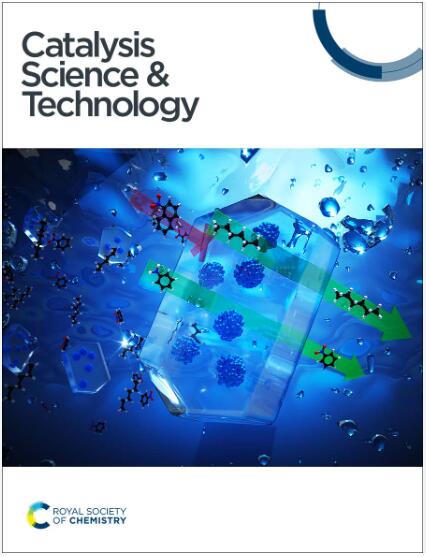Formic acid decomposition over supported Pd alloy catalysts: role of oxygen in hydrogen production†
IF 4.4
3区 化学
Q2 CHEMISTRY, PHYSICAL
引用次数: 0
Abstract
Aqueous formic acid (FA) catalytic dehydrogenation to hydrogen (H2) is a potential green H2 source under ambient conditions (in air). We show that commonly studied Pd nanoparticles supported on CeO2 provide low H2 selectivity and TOF (10%; 20 h−1) against water (H2O) formation from the aqueous FA reaction under ambient conditions. Further, this study explains how Ag alloying of Pd and interfacial sites affect the selective production of H2 from FA with rates and apparent energy barrier measurements without promoters in the liquid phase under ambient conditions. The presence of a high surface coverage of oxygen on Pd–CeO2 decreases the H2 selectivity and promotes H2O formation from the aqueous FA reaction at a temperature as low as 298 K. However, 0.5 PdAg–CeO2 (the atomic ratio of Pd and Ag is 0.5) catalysts provide a higher H2 selectivity (22%) and TOF (178 h−1) when compared to Pd–CeO2 (10%; 20 h−1) at 298 K. Despite the changes in H2 TOF and selectivity, Pd–CeO2 and 0.5 PdAg–CeO2 present the C–H bond activation of formate as a kinetically relevant step for H2 production from FA over a formate covered surface. Even in the presence of an oxidative environment, Ag increases the surface coverage of reduced Pd on 0.5 PdAg–CeO2 compared to Pd–CeO2, and these electronic modifications of PdAg compared to Pd decrease the apparent activation barrier over 0.5 PdAg–CeO2 (8 ± 4 kJ mol−1) compared to Pd–CeO2 (25 ± 3 kJ mol−1) and increase the H2 TOF/selectivity from the FA reaction. Similar-sized PdAg nanoparticles on CeO2 and TiO2 provide comparable rates of H2 production from the FA reaction independent of the identity of the support due to negligible differences in the support basicity. The mechanistic insights of H2 production from FA in the presence of surface oxygen on PdAg catalysts and the derived rate law will aid in the rational design of future catalysts for aerobic H2 production.
负载型钯合金催化剂上甲酸分解:氧在产氢中的作用
水溶液甲酸(FA)催化脱氢制氢(H2)是一种在环境条件下(空气中)潜在的绿色H2源。研究表明,通常研究的CeO2负载的Pd纳米颗粒具有较低的H2选择性和TOF (10%;20 h−1)对环境条件下水FA反应生成水(H2O)的影响。此外,本研究解释了Pd和界面位置的Ag合金化如何影响在环境条件下液相中无促进剂的FA选择性生成H2的速率和表观能垒测量。在低至298 K的温度下,Pd-CeO2表面氧的高覆盖率降低了H2的选择性,促进了水相FA反应生成H2O。然而,与Pd - ceo2(10%)相比,0.5 PdAg-CeO2 (Pd和Ag的原子比为0.5)催化剂具有更高的H2选择性(22%)和TOF (178 h−1);20h−1),298k。尽管H2的TOF和选择性发生了变化,但Pd-CeO2和0.5 PdAg-CeO2表明,甲酸的C-H键激活是甲酸覆盖表面上FA生成H2的动力学相关步骤。即使在氧化环境下,Ag也比Pd - ceo2增加了0.5 PdAg - ceo2上还原Pd的表面覆盖率,并且与Pd - ceo2(25±3 kJ mol - 1)相比,钯的这些电子修饰降低了0.5 PdAg - ceo2(8±4 kJ mol - 1)的表观活化势垒,提高了FA反应中H2的TOF/选择性。在CeO2和TiO2上,相似大小的PdAg纳米颗粒提供了相当的FA反应产氢速率,这与载体的性质无关,因为载体碱度的差异可以忽略不计。PdAg催化剂在表面氧存在下FA制氢的机理及其推导出的速率规律将有助于未来合理设计好氧制氢催化剂。
本文章由计算机程序翻译,如有差异,请以英文原文为准。
求助全文
约1分钟内获得全文
求助全文
来源期刊

Catalysis Science & Technology
CHEMISTRY, PHYSICAL-
CiteScore
8.70
自引率
6.00%
发文量
587
审稿时长
1.5 months
期刊介绍:
A multidisciplinary journal focusing on cutting edge research across all fundamental science and technological aspects of catalysis.
Editor-in-chief: Bert Weckhuysen
Impact factor: 5.0
Time to first decision (peer reviewed only): 31 days
 求助内容:
求助内容: 应助结果提醒方式:
应助结果提醒方式:


